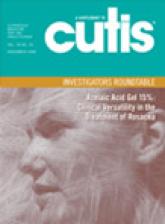Rosacea is a common chronic inflammatory skin disease that primarily affects facial skin. Its etiology is unknown, and currently there is no cure. Rosacea can be associated with severe symptoms, including transient erythema (flushing), nontransient erythema, papules, pustules, and telangiectases, leading to substantial discomfort and an unattractive appearance. This randomized, double-blind, vehicle-controlled, multicenter, parallel-group study conducted over 12 weeks with a 4-week follow-up period evaluated the efficacy and safety of a new formulation of azelaic acid (AzA) foam in a 15% concentration compared to vehicle alone in patients with papulopustular rosacea (PPR). Primary efficacy variables as-sessed were investigator global assessment (IGA) dichotomized into success and failure, and nominal change in inflammatory lesion count from baseline to end of treatment. Results indicated that the new foam formulation of AzA is effective and well-tolerated in a population of patients with PPR. Although no single formulation is appropriate for all patients, the development of a new foam formulation in addition to other available vehicles provides patients with options and allows health care providers to match the needs as well as preferences of individual patients and skin types with appropriate delivery modalities.



